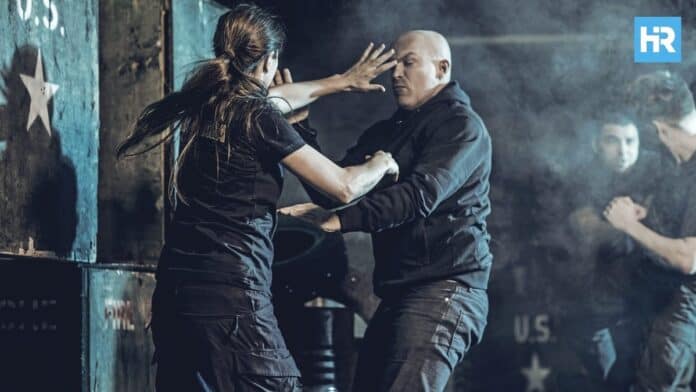Not every martial art is the perfect fit for self-defense. Sure, some styles can be helpful in certain situations or with certain moves, but martial arts alone aren’t a complete solution.
Real self-defense involves more than techniques—it involves being aware of your surroundings, staying calm, and knowing how to act quickly.
That’s why it’s important to find martial arts that focus on practical skills you can use in real-life situations, not just in the dojo.
So, let’s explore which ones are best for keeping you safe.
- Martial arts like wrestling, Wing Chun, and the Keysi Fighting Method focus on skills that work in real-life situations. Wrestling uses grappling to control opponents, while Wing Chun and Keysi focus on fast strikes and protecting important parts of the body.
- It’s helpful to mix arts that teach striking (like Wing Chun or boxing) with those that focus on grappling (like wrestling or Brazilian Jiu-Jitsu) for better self-defense. This gives you more options to deal with different kinds of attacks.
- Modern martial arts, like MMA and Keysi, teach you to be flexible and react quickly. They help you move naturally and think fast, which is important when things get chaotic.
1. Krav Maga
Krav Maga was created by the Israeli military and focuses on real-life situations. Essentially, the goal is to stop threats quickly with aggressive, effective moves.
It teaches you to attack weak spots like the eyes, groin, and throat using punches, kicks, elbows, and knees.
A big part of Krav Maga is learning how to defend yourself against people with weapons, such as knives or guns, and how to handle multiple attackers.
At its core, it’s based on natural reactions and quick counterattacks, so it’s suitable even for beginners.
That said, it’s made for life-or-death situations, but the downside is that some schools don’t do enough hard practice, which can make the training less useful.
Still, when taught well, Krav Maga is great for self-defense.
2. Brazilian Jiu-Jitsu (BJJ)
BJJ is all about grappling and ground fighting, focusing on submission holds that let you control someone without hurting them.
One of the best things about BJJ is that it relies on leverage and technique, which means a smaller person can take down a bigger, stronger opponent.
In self-defense, BJJ is super helpful when the fight ends on the ground, as it teaches you how to control and stop an attacker with joint locks and chokeholds.
However, BJJ has some limits. It’s mostly for one-on-one situations and ground fighting, so it’s not ideal for facing multiple attackers.
Plus, it doesn’t include strikes, which are important when you can’t immediately grapple.
Nonetheless, BJJ is considered one of the most effective martial arts for self-defense because it emphasizes control and technique.
3. Muay Thai
Muay Thai, also called the “Art of Eight Limbs,” is a striking martial art that uses punches, kicks, elbows, and knees to overpower an opponent.
Notably, it’s especially good in close combat since it focuses on powerful hits, particularly with elbows and knees.
Muay Thai fighters practice a lot of full-contact sparring, which helps build mental strength and quick reactions in stressful situations.
For self-defense, Muay Thai’s clinch work—grabbing an opponent and hitting them with knee strikes—helps control an attacker.
While it doesn’t teach grappling or ground fighting, its powerful stand-up techniques are great for defending yourself before a fight hits the ground.
Not to mention, Muay Thai helps build physical strength and endurance, which can be handy in real-life confrontations.
4. Boxing
Boxing is one of the easiest and most useful martial arts for self-defense, mainly due to the fact it focuses on punches, quick foot movement, and head dodging.
As you can imagine, these skills make it good for real-life fights. What’s more, a big part of boxing’s success is its focus on defense, like dodging punches, blocking hits, and striking back.
That way, you can stay protected while staying in control of the fight.
Boxing also teaches you to move and keep your distance from your opponent, which lets you control the fight’s speed.
Overall, it trains you to spot danger early and avoid it, which is important in street fights.
However, boxing doesn’t teach you grappling or kicking, so it’s best to combine it with other martial arts that cover those skills.
5. Wrestling
Wrestling is a martial art that focuses on grabbing and controlling your opponent, making it very effective in self-defense, especially in close fights.
A good wrestler can quickly bring someone to the ground and hold them down, using body control instead of punches.
In fact, wrestling works well if you want to stop an attacker without hurting them too much.
The main strength of wrestling is its ability to control the fight once you’re on the ground, using moves like single-leg and double-leg takedowns to end the fight quickly.
Also, wrestling builds strength and stamina, which gives you an advantage in any physical fight.
However, wrestling doesn’t teach you how to punch or kick, so it works better when combined with a striking martial art like boxing or Muay Thai.
6. Judo
In essence, Judo is another martial art that focuses on throws and submissions.
For self-defense, Judo’s throws are very useful because they use the attacker’s force against them.
Once the fight is on the ground, Judo fighters can use joint locks and chokeholds to control or stop the opponent, making it good for close combat.
Arguably, Judo’s best strength in a street fight is its ability to quickly take down an attacker with a throw, especially on hard surfaces.
On top of that, it teaches staying calm under pressure, which is helpful in real-world fights.
Like wrestling, Judo doesn’t focus on punching or kicking, so it’s often combined with martial arts that do.
7. Combat Sambo
Initially developed for military use, Combat Sambo is a Russian fighting style for soldiers and police. It combines Judo, boxing, and wrestling elements and focuses on self-defense.
What makes Combat Sambo unique is that it allows moves like groin strikes, headbutts, and leg locks, which are often not allowed in other martial arts.
Because of this, these moves are great for real-life situations, making Combat Sambo very flexible.
One important aspect of Combat Sambo is its flexibility. It lets people fight standing up or on the ground and defend against weapons.
Depending on the situation, people learn to use different moves, such as throws, joint locks, and strikes, to stop opponents.
However, finding good Combat Sambo schools outside Russia and Eastern Europe can take time and effort.
8. Mixed Martial Arts (MMA)
MMA is considered one of the best self-defense systems because it combines martial arts, such as Muay Thai, Brazilian Jiu-Jitsu, wrestling, and boxing.
As a result, this gives fighters a wide range of skills to use, whether they are standing or on the ground.
In self-defense, MMA’s mix of punches, kicks, grappling, and submissions makes it very adaptable, letting people control the fight in almost any situation.
Besides, MMA training focuses on being in great shape and using the moves in real fights.
Fighters practice with full contact, which helps them become mentally and physically demanding to use these moves under pressure.
Plus, MMA teaches fighters to defend themselves from both punches and grapples, making it one of the most effective systems for different self-defense situations.
9. Karate
Karate is a traditional martial art with styles like Shotokan, Goju-Ryu, and Kyokushin.
Kyokushin Karate is one of the best styles for self-defense because it uses full-contact sparring and body conditioning.
Additionally, it teaches strong punches, kicks, and blocks that work well in a street fight.
Also, Kyokushin fighters are known for being tough, as they can take hits and deliver strong strikes.
However, the usefulness of Karate for self-defense can depend on the style and the school.
Many modern Karate schools, sometimes called “McDojos,” focus more on scoring points and practicing forms, which might not be as helpful in real-life situations.
So, finding a school that focuses on real self-defense and sparring is important to get the most out of Karate for self-defense.
10. Taekwondo
Taekwondo is one of the most well-known martial arts in the world, famous for its high, fast kicks and quick footwork.
In terms of technique, it focuses on keeping a distance from an opponent, which can be very helpful in self-defense.
Moreover, the fast and strong kicks allow someone to stop an attacker before they get too close.
However, because Taekwondo is often used in competitions that focus on scoring points, it may not always be as useful in real-life situations.
Even so, Taekwondo training improves speed, agility, and flexibility, which can help in real-world scenarios.
The focus on using the legs, which are the longest and strongest limbs, gives a big advantage in reach.
In self-defense, it is important to react quickly and keep a distance, and Taekwondo’s strengths include these two abilities.
Nevertheless, Taekwondo fighters should add training in grappling or close-up striking to be more effective in close-range situations.
11. Keysi Fighting Method (KFM)
The Keysi Fighting Method (KFM) is a newer martial art created in the 1980s by Justo Dieguez.
Interestingly, it focuses on natural movements and real-world situations, making it great for self-defense in unexpected moments.
KFM is known for its focus on close-up fighting and protecting key areas like the head and body.
In addition, it’s designed to work well in tight spaces or when facing multiple attackers.
One of KFM’s core principles is its use of natural body movements and reflexes, which makes it accessible to people of all skill levels.
Notably, it was made with street fights in mind, focusing more on being practical than looking good.
KFM became more well-known after being featured in action movies like the Batman series, but its real strength is its adaptability and effectiveness in stressful, real-life situations.
12. Kung Fu (Wing Chun)
Wing Chun is a style of Kung Fu known for its fast, close-range strikes and practical defense tactics.
In fact, it was developed in southern China and is designed for fighting in tight spaces.
Wing Chun uses quick, direct movements to deal with an opponent and often combines attack and defense simultaneously, allowing you to neutralize a threat quickly.
Wing Chun focuses on efficient movements, using techniques like “trapping hands” (Chi Sau) to block an opponent’s attacks and create openings to strike.
Practitioners also use the centerline theory, aiming at an opponent’s middle for the most powerful hits.
Thus, Wing Chun is very effective for self-defense in small, confined areas, such as narrow hallways or elevators.
One limitation is that Wing Chun doesn’t have ground-fighting techniques, which could be a disadvantage in certain situations.
Many people combine Wing Chun with grappling styles like Brazilian Jiu-Jitsu or wrestling to achieve a more complete skill set.
Find the Best Martial Art for You and Stay Safe
There’s no one-size-fits-all, so find what suits your style and needs. Explore different styles, try out classes, and find the one that makes you feel confident and prepared.
In reality, the best self-defense is about how comfortable and effective you feel using them when it counts.
So take the plunge, start training, and equip yourself with the skills to stay safe in any situation!






